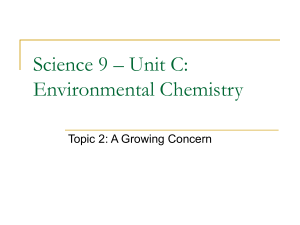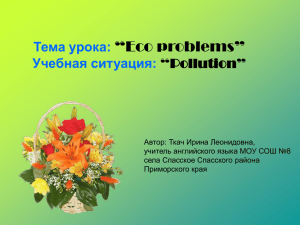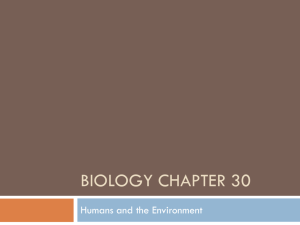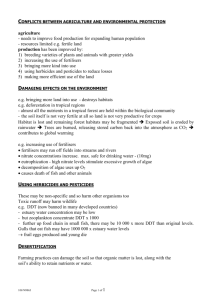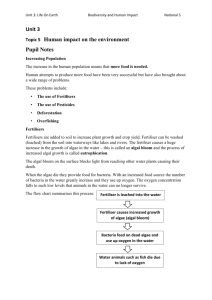Threats to biological diversity 4: Environmental Factors
advertisement
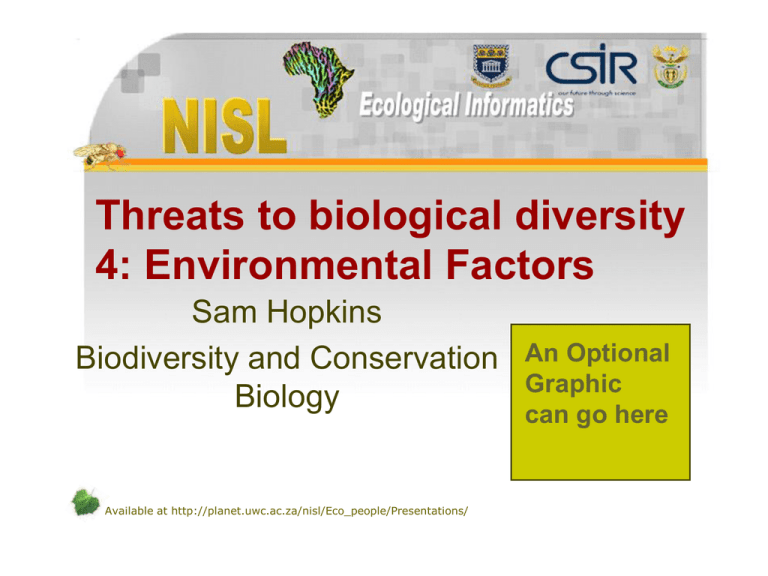
Threats to biological diversity 4: Environmental Factors Sam Hopkins Biodiversity and Conservation Biology Available at http://planet.uwc.ac.za/nisl/Eco_people/Presentations/ An Optional Graphic can go here What Are The Environmental Factors Causing Loss Of Biodiversity? Pollution Litter Oil Spills Pesticides Fertilizers Light Global Warming Pesticides 100s of different pesticides exist Many are worldwide contaminants as they have been carried in the air and water Have been seen as agent of evolutionary change in some species Pesticides: Chlorinated hydrocarbon pesticides (CHs) 1 These pesticides all have Chemical stability High mobility High solubility Toxicity A well known example of a chlorinated hydrocarbon pesticide is DDT Pesticides: DDT 1 Discovered in 1939 First used to kill mosquitoes Used to control against pests such as the elm bark beetle DDT does not just affect the target species DDT is still used in some developing countries Pesticides: DDT Has been seen to bioaccumulate and biomagnify throughout the trophic levels in the environment An example is seen in a study by Boykins (1967) 2 Worms were absorbing DDT The worms kept the DDT 18 months after spraying Birds absorbed the DDT from the worms when they ate DDT caused bird mortality Seen in the artic and sub-artic 3 DDT increased from Ringed and Square flipper seals to Polar bears Polar bear milk contained increased levels of DDT Pesticides: DDT This is not just affecting animals and plants In Kibaha in Tanzania DDT was found in crops 4 The crops were eucalyptus, cashew, plums and casava which are eaten by humans In Mato Grosso, Brazil the DDT in the soil is leaking into the underground water 5 In Turkey DDT has been found in 12 edible fish 6 These are concerns for public health Pesticides: DDT Some animals such as a few of the bird species that showed eggshell thinning are recovering since DDT was banned 1 In Grey Seals since the use of DDT has been stopped the gynaecological problems that the seal populations had have decreased and pregnancies have increased 7 Pesticides: Carbamates and Organophosphates These are the alternatives to the CHs 1 Have been seen to kill herbivorous birds 1 Affects birds that feed on sprayed insects 1 Rainbow trout that were exposed to methiocarb had lemmellar edema and the epidermis became separated from the lamellae 8 One of these is called Dioxin which causes cancer and birth defects in lab animals, this is still in use 1 Many of these substances have now been banned Oil Pollution 1 The estimate of oil input into the environment is 3.2 million tons a year Most of this is from land waste put into the ocean or into rivers Evaporation and combustion allow petrol compounds into the air which are then cycled into the sea More noticeable is the large media events of the ocean oil spills Oil Pollution 1 The worst spill was seen in the Persian gulf This was during the war to liberate Kuwait in 1991 1,700,000 tons of oil was released into the sea Not far off was the spill in 1979 from a Mexican platform 500,000 to 1,400,000 tons of oil was spilt Better publicised are the oil tanker spills such as the Exxon Valdez in Alaska and Amoco Cadiz in France Oil Pollution Case Study: The Exxon Valdez 1 Spill occurred on March 24th 1989 The tanker hit a reef off the coast of Alaska 41,000 tons of crude oil was spilt 40-45% of the oil spilled ended up on the coast Death Toll 350,000-500,000 sea birds 200 bald eagles 3,500-5,500 sea otters 350 Harbour seals 14 killer whales Oil Pollution Case Study: The Exxon Valdez 1 A misguided clean up operation was started Activities lasted four years Shores were washed with hot water and oil and tar was collected Unfortunately the hot washing killed many of the shores invertebrates and pushed the oil onto unaffected beaches The coast that had been cleaned was more damaged than the unclean part Oil Pollution Case Study: The Exxon Valdez Long term affects Fry of the pink salmon were sterile 1 Sockeye salmon could not be harvested, their numbers increased allowing many fry to starve to death 1 Mussels and clams are still poisoned 9 Sea otters have only managed to regain half of their numbers 9 People have had to move away from the coastline as they relied on the fish and seals for food 10 Oil Pollution: Impacts on the wildlife 1 Differs from habitat to habitat In open ocean oil slicks kill plankton and fish and effect sea mammals and sea birds At the coast, sandy beaches can hide oil for months and rocky coasts become coated with the oil and kills almost all the organisms, this can last for years In estuaries and salt marshes the effect of an oil spill are felt the hardest, here the oils can affect the environment for decades as it gets buried in the anoxic sediments to be exposed again at a later date Oil Pollution: Impacts on the wildlife 1 Sea birds suffer the most when oil is spilled into the ocean Many sea birds dive into the ocean to get food, every time they dive they pass through the oil slick This causes their feathers to become oily which in turn inhibits their flight and buoyancy Oil soaked feathers are not good insulators so the birds get cold Trying to remove the oil by preening causes more problems like toxic effects on the liver, kidneys and pancreas Polychlorinated biphenyls 1 Used as insulators and fire retardant Have made way into aquatic systems Long lived High solubility in lipids Food chain magnification Impairs reproductive success in birds and seals and affects polar bears Polynuclear aromatic hydrocarbons Found in petrol and cigarette smoke and given off after combustion of fossil fuels 1 Pollute aquatic environment PAHs are activated by cytochrome P450 and form compounds that damage or mutate DNA, RNA or proteins 11 Some bond with the DNA, RNA or proteins and can cause cancer 11 1 Heavy Metals 12 Heavy metal pollution has been going on for about 8000 years Archaeologists have found evidence of copper extraction and smelting in the Faynan orefield in Jordan 12 Athenian civilisations managed to pollute the air with 2300 tons of copper every year, these figures were calculated from the ice sheets in Greenland 12 Other examples; mercury, lead and nickel 1 Many show food chain magnification 1 Affects fish, marine birds 1 For example gold mining uses mercury to separate the gold and the waste is poured into local water 1 An obscure example is the use of a paint on the hulls of ships that contains tin, it is toxic to marine organisms and is banned in some countries 1 Selenium 1 Naturally occurs in soils Where desert regions are farmed selenium leaches into the local water An example of this was seen in California at the Kesterson National Wildlife Reserve Caused reproductive failure in some birds and birds that did manage to breed hatched deformed chicks Also caused death Radioisotopes 1 For example, caesium, strontium and phosphorous All show bioconcentration and biomagnification A well known example of this kind of pollution was seen at the disaster of Chernobyl Radioisotopes – Chernobyl 13 The Chernobyl disaster occurred in the Ukraine in 1986 There had been a nuclear reactor at the site since 1977 The explosion occurred due to a safety test The explosion exposed the core Radioactive fission products and debris rose 1 km into the air The pollution was carried north-west on the wind The graphite fire lasted 9 days Radioisotopes – Chernobyl 13 The soviet government at the time did not admit that there was anything wrong Only noticed by Swedish workers who saw the smoke A tunnel was dug underneath the core to place a concrete slab and a cooling system The core was placed in a 300,000 ton concrete and steel box Before the box was in place six tonnes of uranium dioxide and fission products along with xenon, krypton, iodine, tellurium and caesium were released into the atmosphere Radioisotopes – Chernobyl The effects of the radiation widespread Caesium has a long half life and is absorbed into the body like potassium so it quickly got into the food chain 13 Radiation got in to the ground water 13 There was a rise in thyroid cancer 13 More than 20 species show genetic damage Radiation reduces antioxidants and immune response in animals 15 Has increased levels of partial albinism Has affected breeding successes of animals 14 15 Radioisotopes – Chernobyl 14 Now the concrete and steel box that is containing the radiation is breaking down Work is being carried out to repair the box A large arch is being constructed to contain the radiation and the concrete box The three undamaged reactors need to be decommissioned Need to dispose of the radioactive waste that was dug into the ground in 1986 Plastic Plastics pollute the land and sea On the Sargaso sea surface there are about 3500 pieces of plastic making up 290 grams per km2 16 Animals are known to eat plastics Sea turtles are notorious for eating plastic bags assuming they are jellyfish Laysan albatrosses have been seen to feed plastic bags to their chicks 1 In a study by Moser and Lee (1992) 1033 birds were collected from 1975-1989 17 21 of the 38 bird species had plastic in their stomach The amount of plastic in the birds stomach increased over time Some birds selected for particular colours or shapes The answer There is no easy answer Man will continue to pollute and the environment will carry on suffering Some governments regulate the use of pesticides Oil tankers are now built with a double hull An international dumping convention in 1972 agreed to by 64 countries states that deliberate dumping of CHs, PCBs, some heavy metals, plastics, petroleum and radioactive waste must be stopped 1 1 Light Pollution This pollution occurs when we switch lights on outside at night Estimates show that two thirds of the population are living in areas above the accepted light pollution level 18 Light pollution affects many species in ways we are only just understanding Trees increase their growing season in the presence of outdoor lighting and are then susceptible to winter frosts 19 The Hawk moth (Deilephilia elpenor) shows decreased ability to see colours in artificially lit environments 20 Artificial light at night increased tumour growth and decreased survival in female rats 21 Global Climate Change 1 Large topic much talked about recently Estimate that 18% of the species in Central America, Australia, South Africa and Europe will disappear 22 Earth warmer now than in the last 40 million years Problems: 23 Change may occur so rapidly that plants and animals cannot adjust Compounded by habitat fragmentation and degradation The new conditions may be more suitable for invasive species Has caused distribution shifts in species Global Climate Change Species are moving pole-wards, global meta-analysis predicts that ranges will move north by 6.1km per decade and spring will become 2.3 days earlier Shown by non-migratory butterfly species, 63% of 35 species have shifted their range northward by between 35240km 24 Species are adjusting their breading seasons Shown by native amphibian species in Britain 25 Species are moving higher in altitude Species are becoming extinct Shown by Bufo periglenes 26 Global Climate Change – Species altering breeding season 25 Study by Beebee (1995) The time that five species entered a pond was recorded over 17 years Bufo calamita and Rana esculenta spawned earlier each year The three newt species arrived 5 weeks earlier in 1994 than in 1978 Pond arrival time of T. vulgaris and spawning of R. esculenta gets 9-10 days earlier every 1 °C increase in temperature Global Climate Change – Species becoming extinct 26 Study by Pounds et al. (1997) The Golden toad (Bufo periglenes) lived in the Monteverde cloud forest It is not conclusive but evidence suggests that the climate changed in the years preceding the disappearance of the Golden Toad The toad relied on the cool, wet cloud forest and water bodies for breeding In conclusion This is an enormous topic and not everything is covered here The human population is doing a lot to pollute the environment The effects of this pollution are not fully understood References 1. Cox, G. W. (1997) Conservation Biology (2nd ed) concepts and applications. Pp 223-232 2. Boykins (1967) The effects of DDT contaminated earthworms in the diet of birds. Bioscience 17:37-39 3. Bowes, G. W. and Jonkel, C. J. (1975). Presence and distribution of polychlorinated biphenols in artic and sub-artic marine food chains. Journal of Fish Research Board, Canada 32: 2111-2123 4. Marco, J. A. M. and Kishimba, M. A. (2006). Pesticides and metabolites in cassava, eucalyptus, plum and cashew leaves and roots in relation to a point source in Kibaha, Tanzania. Chemosphere 64: 542-548 5. Villa, R. D. et al. (2006). Dissipation of DDT in a heavily contaminated soil in Mato Gosso, Brazil. Chemosphere 64: 549-554 6. Coelhan et al. (2006). Organochlorine levels in edible fish from the Marmara sea, Turkey. Environmental International 32: 275-280 7. Bergman, A. (1999). Health condition of the Baltic grey seal (Halichoenis grypus) during two decades. APMIS 107: 270-282 8. Altinok, I. et al. (2006). Effects of water quality and fish size on toxicity of methocarb, a carbamate pesticide, to rainbow trout. Environmental Toxicology and Pharmacology 22: 20-26 9. Black, R. (2003) Exxon Valdez spill still a danger. [cited 2006 July 10] available from: http://news.bbc.co.uk/1/hi/world/americas/3333369.stm 10. Carver, T. (1999) Exxon Valdez anniversary. [cited 2006 July 10] available from: http://news.bbc.co.uk/1/hi/ programmes/from_our_own_correspondent/301097.stm 11. Oh, E. et al. (2006). Comparison of immunological and genotoxilogical parameters in automobile emission inspectors exposed to PAHs. Environmental Toxicology and Pharmacology 21:108-117 12. Grattan et al. (2006). The local and global dimensions of metalliferous pollution derived from a reconstruction of an eight thousand year record of copper smelting and mining at a desert mountain frontier in Southern Jordan. Journal of Archaeological Science (in press) References 13. Blackeye, D. (2004)The chernobyl disaster. [cited 2006 Jul 10] Available from: bbc.co.uk/dna/h2g2/A2922103 14. In depth (2006) Chernobyl 20 years on. [cited 2006 Jul 10] Available from: news.bbc.co.uk/1/hi/in_depth/europe/2006/chernobyl/ 15. Moller, A. P. and Mousseau, T. A. (2006). Biological consequences of Chernobyl: 20 years on. Trends in Ecology and Evolution 21: 200-207 16. Carpenter, E. and Smith, K. L. (1972). Plastics on the Sargasso sea surface. Science 175: 1240-1241 17. Moser and Lee. (1992). A fourteen year survey of plastic ingestion by Western North Atlantic sea birds. Colonial Waterbirds 15: 83-94 18. Cinzano, P. et al. (2001). The first world atlas of the artificial night sky brightness. Monthly Notices of the Royal Astronomical Society 328:689-707 19. International dark sky association (2006) [cited 2006 Jul 10] available from: www.darksky.org 20. Johnsen et al. (2006). Crepuscular and nocturnal illumination and its affects on colour perception by the nocturnal hawk moth, Deilephilia elpenor. Journal of Experimental Biology 209: 789-800 21. Cos, et al. (2006) Exposure to light-at-night increases the growth of DMBA-induced mammary adenocarcinomas in rats. Cancer Letters 235: 266-271 22. Thomas, C. D. et al. (2004). Extinction risk from climate change. Nature 427: 145-148 23. Easterling, D. R. et al. (1997). Maximum and minimum temperature trends for the globe. Science 277: 364-367 24. Parmesan, et al. (1999). Poleward shifts in geographical ranges of butterfly species associated with regional warming. Nature 399: 579-583 25. Beebee, T. J. C. (1995) Amphibian breeding and climate. Nature 374: 219-220 26. Pounds, J. et al. (1999) Biological response to climate change on a tropical mountain. Nature 398: 611-614
